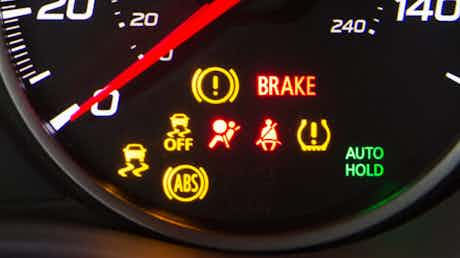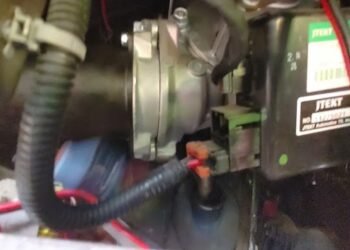Have you ever noticed your car suddenly losing power and sluggishly moving as if it’s in slow motion? That frustrating experience could mean your vehicle has entered limp mode—a safety feature designed to protect your engine from serious damage.
But did you know that a bad battery might actually be the hidden culprit behind this? If your battery is weak, old, or not providing steady voltage, it can confuse your car’s computer systems, causing limp mode to kick in unexpectedly.
You’ll discover how a bad battery can trigger limp mode, why it happens, and what you can do to get your car back to running smoothly. Keep reading—understanding this connection could save you time, money, and a lot of stress on the road.

Credit: www.reddit.com
Limp Mode And Battery Link
Limp mode is a safety feature in vehicles that limits engine power. It protects the engine and transmission from damage. A bad battery can trigger limp mode by affecting the car’s electronics. This connection is important to understand for proper vehicle care.
Battery’s Role In Vehicle Electronics
The battery powers all electronic systems in a car. It supplies energy to sensors, computers, and control units. These parts monitor engine and transmission performance. A healthy battery ensures stable power for accurate readings. Without proper voltage, electronics may send wrong signals.
Voltage Fluctuations Impact
Voltage drops or spikes confuse the vehicle’s control units. A weak battery causes unstable voltage supply. Sensors may report errors or fail to communicate correctly. The car’s computer then activates limp mode to avoid damage. Consistent voltage is key to smooth vehicle operation.
How A Bad Battery Triggers Limp Mode
A bad battery can trigger limp mode in your vehicle by disrupting the electrical system. Modern cars rely heavily on stable voltage to function properly. When the battery fails to provide this, the car’s computer systems may react to protect the engine and transmission.
Voltage drops or irregular power supply from a weak battery cause the Engine Control Unit (ECU) and other modules to misread data. These errors often activate limp mode, reducing engine power to prevent damage. Understanding how a bad battery triggers limp mode helps diagnose and fix the issue faster.
Voltage Sensitivity Of Ecus
ECUs are very sensitive to voltage changes. They require a steady voltage to process sensor signals correctly. A weak battery causes unstable voltage, confusing the ECU. This confusion leads the ECU to trigger limp mode as a safety measure. The system limits power to avoid engine harm during electrical faults.
Sensor Malfunctions Due To Low Voltage
Sensors need proper voltage to send accurate readings. Low voltage from a bad battery can cause sensors to fail or give wrong data. The car’s computer sees this as a serious problem. It activates limp mode to protect the vehicle from possible damage caused by false sensor signals.
Effects After Jump-starting
Jump-starting a car with a bad battery may temporarily restore power. The vehicle’s system often enters limp mode after a jump-start. This happens because the computer needs time to reset. If the battery remains weak, limp mode will continue. Replacing the battery is usually necessary for a permanent fix.
Signs Of Battery-related Limp Mode
Identifying signs of battery-related limp mode helps prevent serious car damage. A weak or failing battery can trigger limp mode by causing voltage drops. The vehicle limits performance to protect critical components. Recognizing symptoms early can save time and repair costs.
Warning Lights And Error Codes
Battery issues often cause warning lights on the dashboard. The check engine light may glow without obvious reasons. Some cars show a battery symbol or a service engine soon message. Mechanics can read error codes using a scanner. These codes help identify voltage or sensor faults caused by the battery.
Unusual Engine Behavior
The engine may hesitate or lose power during acceleration. Stalling or rough idling can occur unexpectedly. Limp mode reduces engine output to avoid damage. You might notice slower throttle response or limited top speed. These behaviors often link to electrical problems from a bad battery.
Electrical System Irregularities
Headlights or dashboard lights may dim or flicker while driving. The radio and other electronics can turn off suddenly. Sometimes the car struggles to start or fails to start altogether. These irregularities suggest unstable voltage from the battery. They often accompany limp mode activation to protect the vehicle.
Diagnosing Battery Issues
Diagnosing battery issues is a key step in understanding limp mode activation. A bad battery can disrupt your vehicle’s electrical system. This disruption may cause the engine control unit to limit performance.
Checking the battery and its connections helps identify obvious problems. Testing battery health reveals if the battery can hold a charge. Using diagnostic tools can pinpoint faults related to the battery or electrical system.
Inspecting Battery And Connections
Start by looking at the battery terminals. Clean any corrosion or dirt buildup. Ensure the terminals are tightly connected to prevent voltage drops. Loose or corroded connections can cause voltage fluctuations. These fluctuations may trigger limp mode in your vehicle.
Testing Battery Health
Use a multimeter to measure the battery voltage. A fully charged battery should read about 12.6 volts. If the voltage is below 12.4 volts, the battery may be weak. Perform a load test to check if the battery holds voltage under stress. A failing battery often causes electrical errors that lead to limp mode.
Using Obd-ii Scanners
An OBD-II scanner reads fault codes stored in your car’s computer. These codes can show battery or electrical system issues. The scanner helps identify sensor errors caused by low voltage. Mechanics use this tool to confirm if a bad battery triggers limp mode. It offers precise information for effective troubleshooting.
Fixes And Preventive Measures
Addressing limp mode caused by a bad battery requires clear steps. Fixing the issue fast prevents further damage and improves vehicle performance. Preventive care keeps the battery healthy and avoids future problems. Follow these simple fixes and preventive measures to keep your car running smoothly.
Resetting The System
Resetting the car’s computer can clear limp mode errors. Turn off the engine and remove the key. Wait for about 10 to 15 minutes to let the system reset. Restart the car to see if limp mode clears. This simple step often helps after fixing battery issues. Sometimes, the system needs a reset to recognize the improved power supply.
Replacing The Battery
Old or weak batteries often cause limp mode. Test your battery voltage and condition regularly. If the battery is below 12.4 volts or shows signs of wear, replace it. A new battery ensures stable voltage to the car’s computer. Professional installation guarantees proper connection and fit. Replacing the battery is a direct solution to stop limp mode caused by power issues.
Maintaining Battery Health
Keep your battery in good shape to avoid limp mode. Clean the battery terminals to prevent corrosion. Ensure tight and secure cable connections. Avoid leaving lights or electronics on when the engine is off. Regularly check the battery voltage and charge level. Use a quality charger if the battery drains often. These habits extend battery life and protect your car’s systems.

Credit: www.carwow.co.uk
Common Causes Of Limp Mode Beyond Battery
Limp mode activates to protect your car from serious damage. It limits speed and power to keep the engine safe. While a bad battery can trigger limp mode, many other issues can cause it too. Knowing these common causes helps diagnose problems quickly. This section explains sensor failures, transmission problems, and engine issues that may lead to limp mode.
Sensor Failures
Sensors send critical data to the car’s computer. When sensors fail or send wrong information, limp mode can start. For example, a faulty oxygen sensor may report incorrect air-fuel mixture. The car responds by limiting performance to prevent damage. Sensor issues often cause false alarms in the system. Replacing bad sensors usually solves the problem.
Transmission Problems
The transmission controls how power reaches the wheels. If it has faults, limp mode may activate. Problems like low transmission fluid or slipping gears can trigger safety limits. The car reduces power to avoid further damage. Transmission sensors and solenoids also affect limp mode. Repairing transmission issues restores normal driving performance.
Engine Issues
Engine problems can cause limp mode to protect vital parts. Examples include misfires, overheating, or low oil pressure. The engine control unit detects these faults and limits power output. This prevents severe damage and costly repairs. Diagnosing engine faults with a scanner helps find the exact cause. Fixing engine issues often clears limp mode automatically.
Credit: f10.5post.com
Frequently Asked Questions
Can A Faulty Car Battery Cause Limp Mode?
Yes, a faulty car battery can cause limp mode by supplying low voltage. This disrupts sensor signals and ECU communication, triggering safety protocols. Check battery health and connections to resolve the issue quickly and prevent limp mode activation.
What Is The Most Common Cause Of Limp Mode?
The most common cause of limp mode is sensor failure, transmission issues, or engine problems like overheating.
How Does A Car Act When The Battery Is Going Bad?
A bad car battery causes slow engine crank, dim lights, and electrical issues. It may trigger warning lights or limp mode.
Can A Bad Battery Cause A Check Engine Light?
Yes, a bad battery can cause the check engine light by triggering voltage drops. Low voltage affects sensors and the engine control unit. This leads to error codes and illumination of the check engine light. Replace or test the battery to resolve the issue.
Can A Bad Battery Cause Limp Mode In Cars?
Yes, a weak or bad battery can trigger limp mode by causing low voltage and sensor errors.
Conclusion
A bad battery can indeed cause limp mode in your car. Low voltage affects the car’s computers and sensors. This leads to errors that trigger limp mode for safety. Checking battery health and connections is key. Replace the battery if it shows signs of weakness.
Fixing battery issues often resolves limp mode problems quickly. Stay alert to battery condition to avoid unexpected car troubles. Simple steps can save you time and money. Keep your vehicle running smoothly by maintaining a good battery.

















